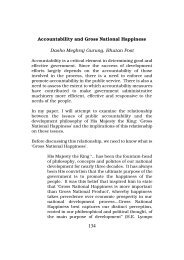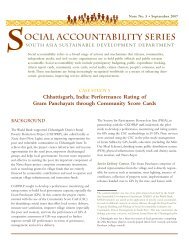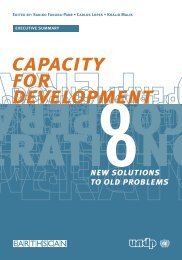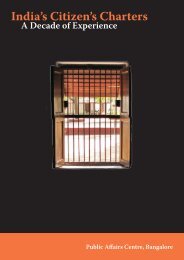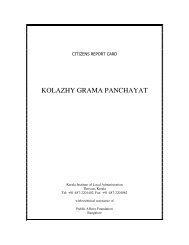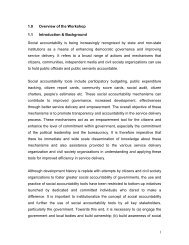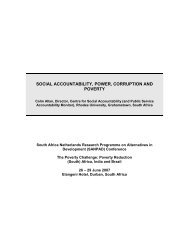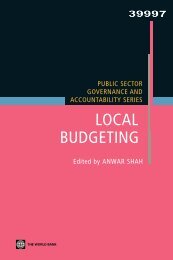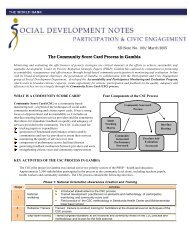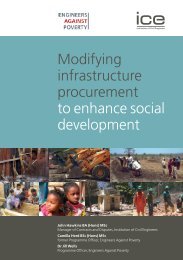Enabling Environment for Social Accountability in ... - SASANet
Enabling Environment for Social Accountability in ... - SASANet
Enabling Environment for Social Accountability in ... - SASANet
You also want an ePaper? Increase the reach of your titles
YUMPU automatically turns print PDFs into web optimized ePapers that Google loves.
and Resources-related issues are discussed <strong>in</strong> various parts of this study, although not as thoroughly as the<br />
issues related to Voice, In<strong>for</strong>mation, and Negotiation, analyzed <strong>in</strong> part III.<br />
S<strong>in</strong>ce the elements of ARVIN are <strong>in</strong>fluenced by factors that are both external and <strong>in</strong>ternal to civil society,<br />
the impact of these factors is briefly outl<strong>in</strong>ed <strong>in</strong> part II. The analytical framework identifies four pr<strong>in</strong>cipal<br />
external factors: the legal and regulatory framework, political factors (<strong>in</strong>clud<strong>in</strong>g governance), economic<br />
issues, and sociocultural characteristics. Internal factors that <strong>in</strong>fluence civic engagement/social<br />
accountability are grouped <strong>in</strong>to three analytical categories: capital (f<strong>in</strong>ancial, human, and physical),<br />
<strong>in</strong>ternal governance, and accountability relationships between CSOs and their constituencies.<br />
1.4 DESCRIPTION OF METHODOLOGY<br />
The study draws on both qualitative and quantitative methods to ensure both breadth and depth. The study<br />
was conducted <strong>in</strong> three stages: the assessment mission <strong>in</strong> Mongolia <strong>in</strong> February 2005, the field research<br />
mission <strong>in</strong> April/May 2005, and the dissem<strong>in</strong>ation mission <strong>in</strong> February-March 2006. Dur<strong>in</strong>g each of those<br />
phases, the team met with government officials, civil society leaders, media workers, parliamentarians,<br />
and representatives from INGOs and <strong>for</strong>eign donors (see Stakeholders’ Map, annex 8). The study team set<br />
up <strong>in</strong>terviews and focus groups to ga<strong>in</strong> <strong>in</strong>sights <strong>in</strong>to the stakeholders’ views on and participation <strong>in</strong> civic<br />
engagement and social accountability. These also provided the team with extensive documentation on<br />
government policies and legislation, the mission and activities of CSOs, and the role of media and<br />
<strong>in</strong>ternational actors <strong>in</strong> support<strong>in</strong>g civic engagement/social accountability, as well as the legal, political,<br />
<strong>in</strong>stitutional, and socioeconomic climate <strong>in</strong> which they operate. 11 The team also reviewed vast secondary<br />
sources be<strong>for</strong>e and after each mission (see Bibliography). The analysis from these various publications<br />
added to the body of <strong>in</strong><strong>for</strong>mation available to the team.<br />
While the focus groups permitted meet<strong>in</strong>gs with more stakeholders <strong>in</strong> a relatively short time, they also<br />
permitted the team to observe the dynamics among them and their level of consensus on key issues<br />
related to civic engagement and social accountability. Moreover, the six focus groups with CSO leaders<br />
permitted follow-up on issues that came out of the CSO Survey and offered an opportunity to pose<br />
broader, more open-ended questions (see Survey of CSOs, annex 6). Participants <strong>in</strong> the CSO focus groups<br />
were selected from among the survey respondents, who fell <strong>in</strong>to two categories: a sample of randomly<br />
selected NGOs registered with the M<strong>in</strong>istry of Justice (35) and a list of “active” CSOs (61), identified <strong>in</strong><br />
consultation with several different NGOs, INGOs, and members of the donor community. 12 The CSO<br />
focus groups were held simultaneously. Plenary sessions were conducted be<strong>for</strong>e and after the focus<br />
groups to present survey f<strong>in</strong>d<strong>in</strong>gs of the CSO survey and discuss both the key issues and<br />
recommendations that participants identified as critical to the enhancement of civic engagement/social<br />
accountability.<br />
In addition to basic demographic <strong>in</strong><strong>for</strong>mation and general questions regard<strong>in</strong>g their <strong>in</strong>volvement <strong>in</strong> civic<br />
engagement and social accountability, the CSO survey specifically probed key issues of <strong>in</strong>volvement <strong>in</strong><br />
social accountability, as well as the enabl<strong>in</strong>g environment <strong>for</strong> voice, <strong>in</strong><strong>for</strong>mation and negotiation as well<br />
11 Outside of direct personal requests <strong>for</strong> documentation, it was surpris<strong>in</strong>gly difficult to ga<strong>in</strong> access to reports on various issues<br />
related to the study. An exception to the rule was the impressive Web site ma<strong>in</strong>ta<strong>in</strong>ed by the Open Society Forum, which has a<br />
wealth of <strong>in</strong><strong>for</strong>mation.<br />
12 The difficulties encountered while conduct<strong>in</strong>g the random sample of registered NGOs, <strong>in</strong>clud<strong>in</strong>g difficulties <strong>in</strong> ascerta<strong>in</strong><strong>in</strong>g the<br />
list from the m<strong>in</strong>istry and locat<strong>in</strong>g selected NGOs, are <strong>in</strong>dicative of a number of issues discussed <strong>in</strong> this report.




